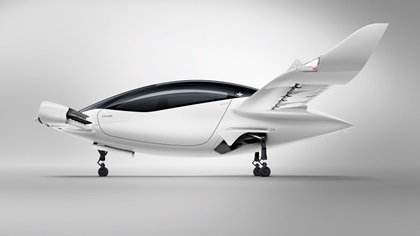Future Flight: Lilium Jet
Jet power in an eVTOL

 Yes, the canard-configuration, five-seat, fixed-gear Lilium Jet derives its power from batteries, but its thrust comes from what the company calls electric jet engines—36 of them, to be exact. These are mounted in ducts within the trailing edges of four articulating flap-like structures. For vertical takeoffs, the flaps can be positioned vertically so that their thrust can be aimed downward. Once in the air, they transition to the horizontal for forward flight. This makes the Lilium Jet something different. Unlike some tiltrotor eVTOL designs, the Lilium Jet is in a class of its own—a tilt-jet, maybe?
Yes, the canard-configuration, five-seat, fixed-gear Lilium Jet derives its power from batteries, but its thrust comes from what the company calls electric jet engines—36 of them, to be exact. These are mounted in ducts within the trailing edges of four articulating flap-like structures. For vertical takeoffs, the flaps can be positioned vertically so that their thrust can be aimed downward. Once in the air, they transition to the horizontal for forward flight. This makes the Lilium Jet something different. Unlike some tiltrotor eVTOL designs, the Lilium Jet is in a class of its own—a tilt-jet, maybe?
The Munich-based Lilium company was founded in 2015 and its CEO and managing director, Daniel Wiegand, says the Lilium Jet was designed with safety and simplicity in mind. There’s no tail, no rudder, no water cooling, no propellers, multiple levels of redundancy to keep it in the air in case of engine failure, and a ballistic parachute for the worst situations. The engines have just one moving part—the rotating fan blades—and require no maintenance.
A full-scale, unmanned, remote-controlled prototype first flew in 2017. Initially, the plan is for a pilot to control the aircraft, but the ultimate goal is autonomous flight. The cabin has two front seats, three back seats, and baggage area at the rear.
Lilium is mysterious when it comes to certain details but allows that the jet will have low noise levels, a top speed of 162 knots, and a maximum range of 162 nm. It will be as energy-efficient per kilometer as an electrically powered car, Lilium says, but travel five times as fast. Apart from that, we’re left with our imaginations. I once planned a visit to headquarters but was told, “There’s nothing to see here.” However, the company has been in the news lately. It has reportedly raised $340 million in funding. Entry into service is planned for 2025.
Lilium’s business plan includes its own air taxi service. Like Uber, customers would use an app to call up a ride, meet the aircraft at a rooftop or other suitable landing pad, and be whisked away. Check out the website for some cool videos of a test flight.
Email [email protected]



